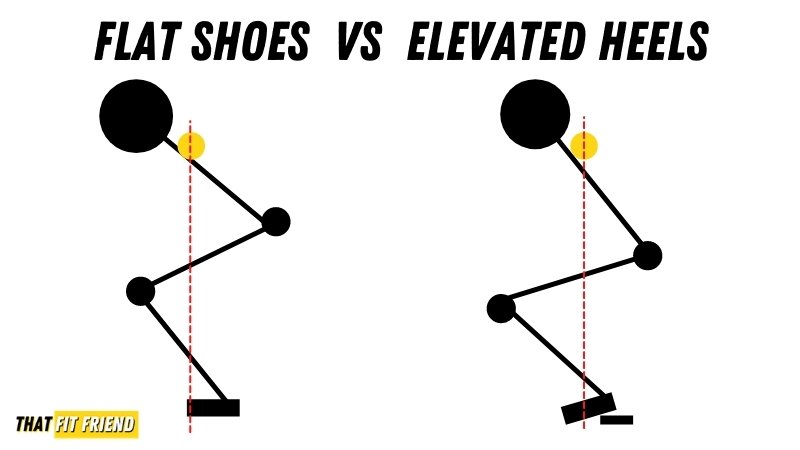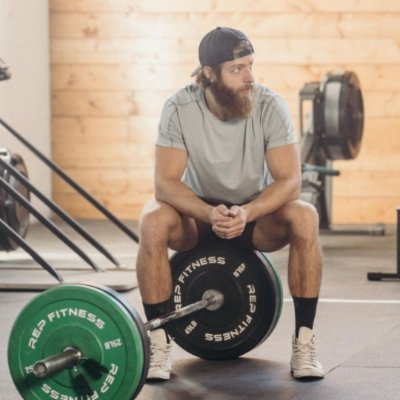One of my favorite topics to discuss with lifters is how to get more out of their barbell lifts (and really all exercises) by shifting their biomechanics to accommodate their limb lengths and leverages.
Far too often, lifters neglect their anatomy along with tools like squat shoes (weightlifting shoes) when trying to optimize exercises like the barbell back squat and deadlift.
The truth of the matter is this, not every lifter is built to perform optimally in exercises like barbell squats. However, that’s not an excuse to avoid them especially if you want to perform them. For example, I am not necessarily optimally built for back squats, I have long femurs and shins which make achieving depth for me somewhat of a constant battle.
In addition, I compete in powerlifting regularly so I need a ton of strategy when attacking back squats to optimize my performance goals per my anatomy and competition goals.
To assist my tall lifter friends, I wanted to put together an article and discuss why squat shoes can be important to consider for your performance.
Squat Shoes for Tall Lifters
When discussing squat shoes (also referred to as weightlifting shoes) for taller lifters, we need to assess how an elevated heel can generally support this type of lifter’s performance. If you have longer femurs and shins, then you’ll usually need a higher degree of ankle mobility to achieve greater ranges of motion and depth in the squat.
This means that generally compared to a shorter lifter with less total range of motion to travel in the squat, you’ll need greater levels of dorsiflexion to achieve similar squat depths.
When we elevate the heel we put the body, and more specifically, the knees into an environment that promotes forward knee translation (ankle dorsiflexion) while maintaining a more upright torso position.
Dorsiflexion Definition: The act of flexing the ankle upwards, thinking toes to the sky.
When we discuss specific ranges of motion in exercises, it’s important to note that they’re task-dependent. This means that while we talk about needing greater levels of dorsiflexion in the squat above, you only need the amount that is going to allow you to perform your best technical squats.
There is no magic level of ankle mobility that you need outside of what’s task-dependent for you and this is why I recommend most tall lifters explore squat shoes to support their performance.
In some cases, tall lifters try to force ankle mobility levels that they’ll never possess, when in reality, if you just elevate the heels you’ll be far better suited to perform optimally and not waste time on mobility drills that may not even stick.
Moving forward, when we talk about back squat performance output for tall lifters, we need to first discuss how we want to standardize output. In the context of this article, when I say performance output I’m referencing executing lifts with high intent of effort with technical proficiency.
Basically, moving big weight and working with your mechanics to do so, and not against your anatomy.
What Can Cause a Tall Lifters Squat Performance to Suffer?
When working with taller clients, I’ll generally see three squat faults that cause this lifter’s performance output to suffer. Note, there are multiple reasons why these squat faults might be occurring, but more often than not, little tweaks to one’s positioning like elevating the heel with squat shoes can go a long way at naturally boosting their squat performance output.
1. Forcing Range of Motion and Causing Butt Wink
The first squat fault is forcing a range of motion, then causing butt wink or the tucking/rounding of the pelvis at greater depths in the squat. Butt wink is the result of being capped at a certain depth in the squat, then driving the hips and pelvis past that point, so the lower back rounds to accommodate.
Is butt wink inherently dangerous? Not necessarily and research is still conflicted on this topic. However, I’m more interested in performance and how butt wink can cause dips in outputs.
When we drive past our body’s comfortable range of motion for things like depth we start to lose out on elements that assist with strong performance.
In the context of butt wink and tall lifters, once the pelvis and hips start to tuck, we start to lose out on two things. One, we disengage the glutes to help stabilize the hips and create extension when coming out of the hole.
Two, we often shift our balance and the bar’s positioning away from the mid-foot, which is not ideal for creating power.
2. Not Allowing the Knees to Track (At All)
The second squat fault is sitting back too far and limiting the knees from tracking whatsoever. The cue “sit back” in the squat is a cue that is often misapplied and this is why we have so many lifters afraid to let their knees track over the toes.
If you’re a taller lifter, then you’ll need some level of knee tracking to perform strong squats, more often than not, you’ll need more knee tracking than a shorter lifter.
If you limit knee tracking in the squat, then you’re asking your body to move a great range of motion without squat prime movers assisting with mechanics and form. Remember, the quads are a prime mover in the squat, and the less we allow the knees to track forward, the more we limit their potential to assist with our mechanics.
Hip-dominant squats have a time and place and there’s nothing inherently wrong with being a hip-dominant squatter. However, context is always needed, and this natural inkling to not let the knees track at all ends up hurting taller lifters’ squat performance most of the time. Even a little tracking goes a long way when under load.
3. Folding Over At the Torso
The last squat fault is folding over at the torso and not being able to maintain some level of torso integrity through the squat. This essentially means that at certain ranges of motion, usually when achieving greater squat depths, a lifter starts to fold over at the torso versus fighting to maintain a consistent torso position.
Folding at the torso is generally caused by a lack of form cognizance and forcing a range of motion that the body is not positioned correctly to handle. This doesn’t mean the range is not there, but more so, that you’re not in an environment to handle the task at hand without needing to fold the torso to execute your squats.
How Elevating the Heel Supports Tall Lifter’s Squats
Thus far, we’ve talked about what elevating the heel does for squats and what squat faults tall lifters can generally run into, now let’s bridge everything together.
Squat shoes typically come with heel heights that range between .6″ and 1″. For taller lifters who find that their squat performance is always limited to a certain range of motion and they constantly are losing a mid-foot bar position, then they may want to explore opting for a taller heel.
A more elevated heel will assist with greater forward knee translation, which can then allow tall lifters to maintain a more upright torso position and mid-foot bar position (reference the example above!). Better torso positioning will result in better balance and leveraging of the squat prime movers (squats, glutes, and adductors).
Squat Shoe Heel Elevation Suggestions
If you’re a high-bar squatter that relies on a more upright torso position, then I’d recommend looking into shoes like the Nike Romaleos 4s or Reebok Legacy Lifter 2s as these both have heel heights around .79″.
For low-bar squatters that need a little assistance with torso positioning, then the Nike Savaleos and Adidas Powerlifts can be good options because their heel height is slightly lower around .6″.
- If you need a bit more forward knee translation, then opt for heel heights of .75″ – 1″.
- If you need some forward knee translation, then opt for heel heights of about .6″-.75″.
The difference between these two options doesn’t seem like a lot, but details matter when maximal performance output is the goal. Higher heels will promote more forward knee translation, while lower heel heights will do the same regarding forward knee translation, but not necessarily as much.
Tips to Acclimate to Elevating the Heel In Squats
If you’re reading this article and thinking about elevating the heel to assist your squat performance, I wanted to provide a game plan for doing so. There will be a shift in your squat mechanics from moving from a flat to an elevated heel, usually for the better, and I have a few tips to acclimate to this change with strategy.
1. Slow Down and Film
If you’re just starting to experiment with squatting with an elevated heel, then I’d highly suggest implementing tempo and videoing yourself from the side. A slower tempo will allow you to focus on what’s happening at the knees and hips during your squat and by videoing yourself from the side you can watch your bar path and make adjustments accordingly.
- Tempo Suggestions: 3110
- This means using a 3-second eccentric/lowering tempo, pausing for a second at the bottom, then standing up and repeating this process at normal speeds.
- Video Suggestions
- Set your camera up to the side and watch the end of the barbell about its position to the mid-foot. If it’s shifting forward a lot, then play with bar positioning and torso mechanics, and if it’s shifting behind the mid-foot, then explore what the knees are doing regarding their tracking.
By taking a mesocycle (3-6 week training block) to implement these strategies you’ll create a better means of being consistent with the mechanical change of elevating the heel.
2. Try Plates/Wedges Before Investing In Shoes
This article is not intended to sell you on buying more shoes. That being said, an easy means to experiment with elevating the heels when squatting is to place 5/10 lb plates under the heels or use physical wedges to play with your squat mechanics.
Both of these options can be useful and similarly to the tip above, dropping the load slightly can be a good means to adjust and manage what your hips and knees are doing about your torso to get the most out of your squat.
Takeaway Thoughts
Squats are an exercise that some lifers naturally excel at while others have a work a bit harder to nail their lifting mechanics. More specifically, barbell squats can usually be a bit tougher for taller lifters, but that’s not an excuse to not perform them and execute crispy clean reps.
Squat shoes are only one of the many tools tall lifters can use to perfect their squat form. If you’re taller and find yourself limited in the squat and traditionally squat with a flat-footed position, then I’d highly suggest experimenting with squatting with an elevated heel.
If you have any questions at all, drop them in the comments below, and if you want more personal advice/form feedback, hit me on Instagram (@jake_boly)!











Add a Comment